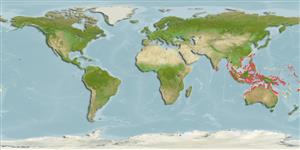Preferred temperature (Referencia
123201): 25.4 - 29.3, mean 28.6 °C (based on 2251 cells).
Phylogenetic diversity index (Referencia
82804): PD
50 = 0.5078 [Uniqueness, from 0.5 = low to 2.0 = high].
Bayesian length-weight: a=0.01479 (0.00651 - 0.03363), b=3.00 (2.81 - 3.19), in cm total length, based on LWR estimates for this (Sub)family-body shape (Ref.
93245).
Nivel trófico (Referencia
69278): 2.7 ±0.18 se; based on food items.
Resiliencia (Referencia
120179): Medio, población duplicada en un tiempo mínimo de 1.4-4.4 años (Preliminary K or Fecundity.).
Fishing Vulnerability (Ref.
59153): Low vulnerability (10 of 100).
🛈
Nutrients (Ref.
124155): Calcium = 82.7 [45.2, 136.7] mg/100g; Iron = 0.689 [0.421, 1.073] mg/100g; Protein = 19 [18, 20] %; Omega3 = 0.135 [0.086, 0.212] g/100g; Selenium = 19.4 [11.5, 35.3] μg/100g; VitaminA = 109 [36, 318] μg/100g; Zinc = 2.12 [1.51, 2.91] mg/100g (wet weight);
